I have no better way to describe the impetus for this trip than Michel Digonnet has so expertly done in Hiking Death Valley. One read of this, and I was sold - it was time to visit the Owlshead Mountains.
At the south end of Death Valley, between the imposing Panamints and the mysterious Avawatz Mountains, the land gathers up into a colorful aggregate of low ranges collectively known as the Owlshead Mountains. Believed to be the eroded and partly collapsed remnant of a once much taller range, they consist of a roughly circular arrangement of hills surrounding two dry lakes. The name is said to have been inspired by the resemblance of Owlhead Peak's outline to the head of an owl. It is a coincidence that decades later, after the area was fully mapped, the shape of the range also turned out to look like an owl's face, the two dry lakes depicting the eyes.
Far from main lines of travel, accessed mostly by long primitive roads, and eclipsed by more formidable neighboring ranges, the Owlshead Mountains rank among the least visited in the park, which makes for superbly secluded hiking. Because it takes so long to drive to the few areas accessible by car, and even longer to walk anywhere else, to amortize your driving investment it is best to come here for a few days.
Total immersion in the Owlshead Mountains is pure bliss - you may well encounter more wild burros than humans.
@mrs.turbodb was along for this trip - a nice bonus for me, as I always enjoy the experiences more when I can share them with her, and we made the long, 17-hour drive down to Beatty in a single day. We listened to quite a few podcasts before climbing into the tent just before 3:00am on some BLM land outside of town.
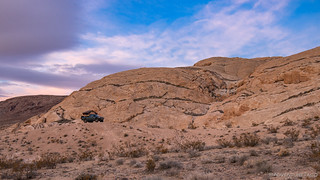
Our home for four hours.
Up just after sunrise, we filled the tank - goodness, gas is getting pricey, even in Beatty - and headed toward the park. We didn't make it far - not even to the park entrance - before our first detour. Not so long ago, I'd seen a couple photos that Mike @mk5 had posted of the artwork at the Goldwell Open Air Museum outside of Rhyolite, and there were a couple new installations that I figured we would enjoy checking out.

I don't think that the ghost on a bike is new, but I do like it.

Pretty sure the crane is new. @mini.turbodb loves making these, and we would come full-circle with origami cranes at the end of the trip.

These weird - sort of squares - were most definitely new, and were what piqued my interest. What in the world are they about?

Now we're getting the idea.

Bingo! A "picture frame" for the naked Minecraft lady.
We didn't spend too long at the museum - and we skipped Rhyolite altogether - before getting back in the Tacoma for more driving. Even as we'd finished the first 17 hours, we still had a long way to go in the park - hours of driving - to get ourselves down to the Owlshead Mountains.
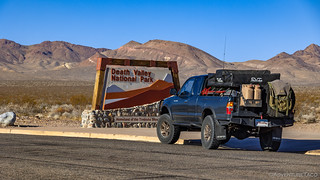
A familiar sign that I enjoy each time I pass.

Descending Daylight pass. We're really here - for the first time this fall!
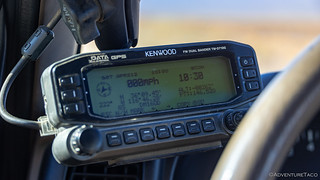
It's not too often that the elevation on the GPS goes bonkers.
Having gotten out of camp at 8:00am, it was nearly 11:00am when we finally reached the region of the park we'd set out to explore. Only four roads approach these mountains, and not in a way that allows access from four different directions - that would be too convenient. Rather, one must follow the Harry Wade Road from its intersection with CA-190, as it runs south through southern Death Valley a few miles east of the Owlsheads. Then, the Owl Hole Springs Road follows the south side of the mountains to Owl Hole Springs at the regions' southeast corner. From there, Owlshead Mountain Road heads west - to a remote radio facility in the southwest corner. Graded up to the springs - and primitive beyond - it is a long drive. This is not the kind of place one drives to for the day.
We, would be here for three!
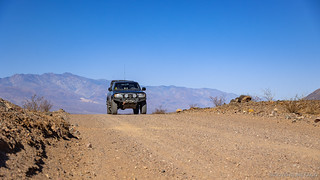
Onto dirt at Harry Wade Road.

The Owlshead Mountains, where we'd be spending our entire trip!

Fabulous folds to explore.

The last human we'd see, getting Owl Hole Springs Road ready for winter.
I hadn't expected Owl Hole Springs to offer much in the way of "interesting" stuff to look at - even with its remote location, it's reasonably accessible and I suspect that most people make it their final destination in this area of the park. Still, after a lot of seat-time, we weren't going to pass up an opportunity to look around, and we exited the truck just in front of the spring.
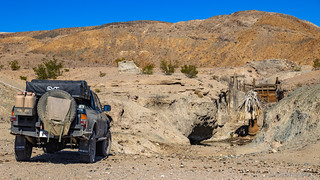
Not much to look at.
The spring itself was surprising - to me - for two reasons: first, there was water in it. There are many springs in Death Valley, but I don't think I've stumbled on more than one or two that actually still had water in them - especially late in the fall. Second, it was surprising to see that what appeared to be an old loading or storage platform of some sort was built right on top of the spring. A lone palm tree - now dead - once provided shade to the burros that still - obviously, judging by the smell - use the spring regularly.
Wandering around, there were a few other run-down mining artifacts that we were able to check out as well. The two most interesting were a dilapidated old ore chute, and a pile of enormous stockpile of iron (?) ore.

There were some smaller pieces of these rocks laying on the ground, and they seemed to be about twice as heavy as we expected.

Ore chute.
Ready to move on, our first exploration was into a group of mines along Manganese Ridge. These mines are accessible on foot, or by a barely-there-high-clearance-4wd-road, and we choose both methods of travel to avail ourselves of their remains. The first two - the New Deal Mine and Owl Hole Mine - were a half-mile up the wash, and then a two-mile (round-trip) hike up adjacent side canyons.
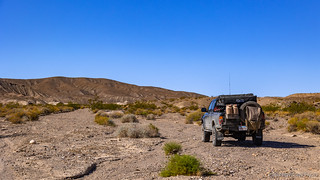
A wash, or a road? Why can't it be both?
We knew we'd reached the right place when I spotted the carcass of an old teal car nestled into the side canyon. A bit rusty - but still more structurally sound than most 1st gen Tacoma frames - @mrs.turbodb led the way as we set out toward the New Deal Mine.

A desert treasure.

Just a little surface rust.

Calcite crystals that were all over the ground in this area.
The New Deal Mine was the area's best manganese producer. Its original workings are still there - a collared two-compartment shaft, and a cavernous tunnel framed with blood-red minerals. Between 1914-1918, the New Deal produced 3,000 tons carrying on average 45% manganese. Most of it came out of a 90-foot inclined shaft and a 75-foot adit that probed two parallel veins, 4 feet wide at places. The mine was re-opened during World War II, and in 1946 a 30-ton mill was moved in from the infamous Death Valley Mine in the east Mojave Desert and reassembled at Owl Hole Springs for use by the New Deal Mine. The ore was milled in a jaw crusher, ground in a rod mill, then concentrated and sintered into a manganese-rich cake. When the mine was abandoned in the fall of 1950, it had become the county's largest manganese producer, with a total output exceeding 15,000 tons of 20% ore.Hiking Death Valley

The head of the 90-foot, collared, two-compartment, inclined shaft.

The cavernous tunnel.

Looking out from the tunnel.
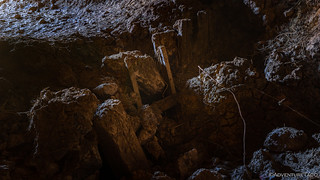
An old ladder leading down, now blocked by a cave-in.

I always find desert mud fascinating.
Without any machinery or buildings to explore, the history of the New Deal Mine was the highlight of this part of our hike. After looking around - and being told in no uncertain terms that I was not to climb down the two-compartment inclined shaft - we continued to the head of the wash, where we could cross over into the canyon that housed the Owl Hole Mine.

Arriving at the Owl Hole Mine.
The Owl Hole Mine was discovered in 1910 by Alex Yeoman, but was never as successful as the New Deal Mine just a side-canyon away. Worked until 1915, and again in 1918, it only ever produced 800 tons of ore - though that ore was quite rich at 40% manganese.

Inside one of the Owl Hole Mine shafts, a 4x4 post and several busted-apart drawer sides - with finger joint ends still intact - kept the entire mountain from falling on us.

Even further inside, I made a wonderful discovery - a still-framed inclined shaft. I was even able to get @mrs.turbodb to check this out.
Like the New Deal Mine before it, all that remained of the Owl Hole Mine were its workings - no buildings or machinery were abandoned at this mine for us to wonder over all these years later. And so, the workings explored to the extent that we felt comfortable, we headed back down to the Tacoma to continue up Manganese Ridge to explore the remaining two mines.
Oh, and by now we were both starving, so I suggested that we eat lunch when we got to the Black Magic Mine - some four miles up the road, and the next mine on our route. I got instant agreement from the passenger seat.

Back to the truck, headed up the wash. Death Valley in our rear view mirror.
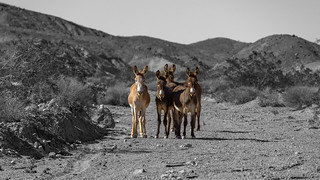
Stand-off with the local riff-raff.

The first of five mylar balloons we'd toss in the Trasharoo on this trip.

At a short dry fall, the wash gave way to a slightly-more-road-like-wash, and we could just see the structure of a Black Magic Mine ore chute peeking out above us.
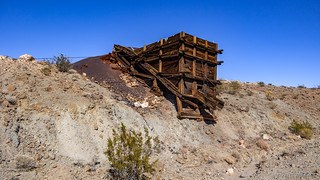
The ore chute.
The ore chute is - by far - the largest ruin at the Black Magic Mine. It's sturdy frame is made of bolted beams and is tethered to ground anchors with large cables. A chute, a lever that still operates a working trap door, and corrugated metal lining all remain well-preserved to this day, few visitors making it to this area to accelerate the decline. Strewn around, black and red ore pellets cover the loading level above the chute, a hint that there was once a crusher nearby.
Less than a mile from the chute, we found ourselves at the end of the Black Magic Mine spur road, and while @mrs.turbodb set about assemblage of tuna sandwiches, I made a quick dash up to the top of the ridge to get a peek at our surroundings.
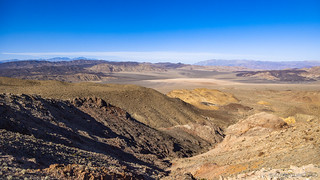
Looking north, into the heart of the Owlshead Mountains, the dry bed of Owl Lake in the valley.

A little closer look at Owl Lake.

View to the southeast, and the colorful hills that contained the Ellie Iron Mine.

More local riff-raff. A colorfully side-blotched lizard.
And then, I heard it - music to my ears - our family whistle. I knew that meant that I was missing out on potato chips, so I wasted no time in making my way back down the ridge to where camp kitchen had been temporarily deployed and @mrs.turbodb was setting out our rocking camp chairs to enjoy our sandwiches with a view over the mountains and down to the valley - though we were just low enough now that we couldn't see Owl Lake. I don't think I've ever eaten a sandwich so quickly.
From the Black Magic Mine, it was approximately a mile to the end of the road and the Ellie Iron Mine. That mile was anything but boring - as though the Black Magic miners had been a quarreling couple - each one throwing all the other's belongings out over the hillside, never to be retrieved again.

Anyone need a cab? Lightly used, with authentic patina.

Another old vehicle, which we mistook for a Jeep from a distance, due to the round headlights and custom wire grille.

On our way to the end of the road and the Ellie Iron Mine.
At the end of the road, the Ellie Iron Mine is situated at the geographical center of the mines of Manganese Ridge, and boasts - by far - the largest remaining exposures of lustrous metallic boulders. Unlike the other mines in the area, this iron deposit was largely undisturbed until 1981 when Jebco, Inc. opened the mine and extracted 7,000 tons of hematite (iron ore) over a six-month period in order to make portland cement. Then, in 1982, the mine shut down, leaving - to this day - an estimated 20 million tons of iron ore in the ground.
Today, that'd be worth $2.5 billion. Yep, that's with a B.

End of the road, with views for miles.

A 20-foot pillar iron of on the lower platform of the Ellie Iron Mine.

Colorful ground.

Another view of the end of the road.
Having explored what there was to explore along Manganese Ridge, we retraced the five-mile trail back to Owl Hole Spring, and turned west. It was 2:45pm and we were already on our way to camp. But we weren't done for the day - not by a long shot.

Headed west, along the southern edge of the Owlshead Mountains.

Arriving in the valley we'd call home for the night.
As I pulled off of the road and into camp - immediately adjacent to said road - we could see the subject of our final push for the day, far in the distance. We'd arrived - as close as we could drive anyway - at our jumping off point to Lost Lake.
Shaped like a slitted iris, Lost Lake is two miles long and a half-mile wide. Located in a shallow depression, it is one of the park's most isolated dry lakebeds, requiring not only the extended drive, but also a brisk-paced, two hour walk to reach the far end. It is a special place - one rarely visited by humans - beautiful in its starkness. Like the Racetrack and Alvord Playa, it is a giant playa of hardened silt - perfectly flat to the naked eye - free of vegetation.
Trapped between long parallel ranges of the Owlshead Mountains, it is also the floor of a spectacular wind tunnel - a perfect playground for rocks to go wandering while no one is watching. 
But, before we could head that direction, and even before I could get the tent deployed, we decided to have a late-afternoon snack and rest for a few minutes. Four hours of sleep in 36 hours is apparently a bit tiring.

Never seen a wild tarantula before. This little guy was small...and yet quite large.

And he had a temper.
Update: After posting this story, I was lucky enough to have a reader - who bred tarantulas - reach out to me with the following fascinating details:
Hi, thought you might be interested to know that the Tarantula you took a picture of is an adult male out looking for a female.
On the picture you posted with the tarantula facing you and left front leg in the air and fangs bared you can see a downward facing hook on the first or second segment of the front leg. There is another hook on the right leg. These are only on adult males after their last molt. The male will use the hooks to lift the female and insert his sperm.
After the male molts for the last time and develops these hooks he will live a few months and die - that is if a female (which can live around 30 years) doesn’t have him for a meal after they breed. You will almost never see a larger female out and around as they rarely leave their burrow.
If the male’s threat display does not scare you off they will unleash a bunch of urticating hairs from their abdomen with their back legs which are barbed hairs. The hairs are much more irritating than fiberglass. You do not want these hairs in your nose, mouth, eyes. Even on your skin they will itch like crazy.Ed Rogers
After snapping about 50 photos of the tarantula, I finally got the tent set up, and we started getting ready to go. My plan - in as much as I had one - was to end up on the lake bed at sunset. I figured that would give some fantastic light to photograph the geometric patterns in the dry mud, and maybe also catch some long shadows on the wandering rocks that had skated across the surface.

Camp in the middle of nowhere. Perfection.

Surely the lake bed isn't actually four miles away. It looks much closer, doesn't it? (Hint: it's actually four miles.)
In the end, we set off about 30 minutes too late on what would end up being an eight-mile roundtrip hike to Lost Lake. I'd realized our mistake about a mile into our trek across the valley - the lake seemingly further away, the longer we walked - and though we'd picked up our pace dramatically, we were still a mile or so from the dry lake bed as the sun set at 6:00pm, the skies alive with color I'd hoped to capture from the lake.

A barren patch, but not the lake bed.

More color, Lost Lake still in the distance.
I can't say I was all that happy at this point. But I continued on, trying my best to enjoy the show even as I thought to myself that a few fewer photos of the tarantula, or a bit faster driving on the way to camp, might have meant we'd be out on the lake by now.
And then, I arrived.
Luckily, I'd had the forethought to bring the tripod - knowing that whatever the time, light would be low at best - and I quickly set it up as I walked toward the middle of the lake. Around me, the fractal pattern created by the cracked mud extended out seemingly forever.
And then, under the most fabulous light, I found a sailing stone. With a long exposure and plenty of joy, I captured its path just as @mrs.turbodb joined me on the playa.

Where are you going little guy?
There wasn't enough light to do much of anything else, so - having spent all of 3 minutes on the playa - we donned our head lamps and retraced the four-mile trek back to camp. Half way back, it was dark. Really dark. And that turned out to be a great thing - because there, above our heads in the sky, in all its glory, was the Milky Way.
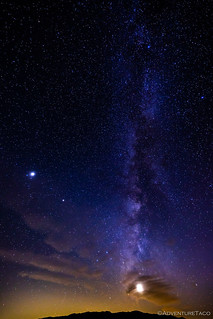
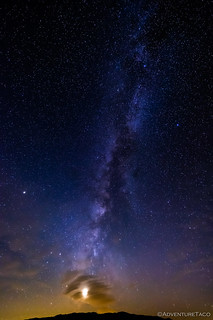
Nothing like a moonless night in the desert.
We arrived back at camp around 8:30pm - a dinner of tacorittos all that stood between us and our first full night of sleep in 48 hours. Though tiring, it'd been a pretty great start to a trip that would bring all sorts of surprises - not the least of which was our anticipation of hiking right to the edge of the Naval Air Weapons Station China Lake.
The Whole Story
Love Death Valley? Check out
Death Valley Index
for all the amazing places I've been in and around this special place over the years.





OMG...
Great pics! Milky Way photos are stunning...!
I have "Mind-Surfed" that dry lake at least 30 times, thinking there was a way to drive to it. Are there signs prohibiting entry in that area? There is a faint track that runs around the West side then up to the NE. Cheers, Paul
Another great trip with magnificent colors in the rocks. The tubing frame looking at the minecraft lady is the entrance to the twilight zone. It will transport you into another dimension of joy and serenity.
Great photos as always!
thanks for sharing.
Thanks Kenny! As always, happy to have you enjoying the posts. And, I'll take that other dimension any day! ?
A wonderful trip, thanks
Always a great read but this post has some (extra) amazing shots.